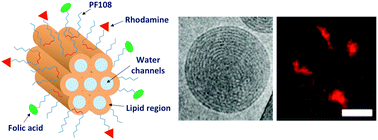Theranostic hexosomes for cancer treatments: an in vitro study
Abstract
We have formulated and investigated innovative lipid-based nanoparticles characterized by a reverse hexagonal liquid crystalline inner structure (hexosomes). These nanoparticles were doped with a potent, highly water insoluble anticancer drug, namely docetaxel, and stabilized by a mixture of commercial and folate- and rhodamine-conjugated Pluronic F108. Thus, they simultaneously possess therapeutic, imaging, and targeting properties toward cancer cells. The morphological and structural aspects of the hexosomes were investigated at different temperatures (10, 25, 37, and 50 °C), and our results demonstrate good performance in terms of stability of these nanoparticles. The latter was furthermore confirmed by the very slow and continuous release profile of docetaxel observed in drug release experiments. Although it was not possible to assess a specific compartmentalization of the dye, this formulation allowed the successful visualization of HeLa cells. Finally, cytotoxic assays showed a 20-fold higher toxic effect of the drug-doped hexosomes against HeLa cells with respect to the free (not loaded in hexosomes) anticancer drug. On the whole, these results indicate that this formulation is a potential theranostic tool in oncology.



 Please wait while we load your content...
Please wait while we load your content...